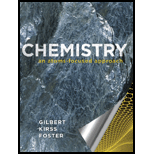
To find:
a) which metal among potassium and sodium would emit electrons with the greater velocity.
b) Velocity of the ejected electrons.
Answer to Problem 3.41QA
Solution:
a) Potassium metal would emit the electrons with greater velocity.
b) Velocity of the ejected electrons is 8.04 x 105 m/s.
Explanation of Solution
1) Concept:
We have to use the formula of work function relating kinetic energy. We have given wavelength of the radiation and also work functions of the metals. We have to first calculate the kinetic energy and then velocity of the ejected electrons.
2) Formula: for the velocity of the ejected electrons is,
Where, m is the mass of the electron.
3) Given:
i. Wavelength of the radiation = 300 nm = 3.00 x 10-7 m
ii. Work function of potassium = 3.68 x 10-19 J.
iii. Work function of sodium = 4.41 x 10-19 J.
iv. Mass of electron = 9.1 x 10-31 Kg.
4) Calculations:
• Potassium:
Now velocity of the ejected electrons,
• Sodium:
Now velocity of the ejected electrons,
Comparing the two velocities we can say, potassium will emit electrons with greater velocity –
Conclusion:
The work function of potassium is less than the work function of sodium. This means the kinetic energy and therefore the velocity of the electrons emitted by potassium would be greater than those emitted by sodium.
Want to see more full solutions like this?
Chapter 3 Solutions
Chemistry: An Atoms-Focused Approach
 ChemistryChemistryISBN:9781305957404Author:Steven S. Zumdahl, Susan A. Zumdahl, Donald J. DeCostePublisher:Cengage Learning
ChemistryChemistryISBN:9781305957404Author:Steven S. Zumdahl, Susan A. Zumdahl, Donald J. DeCostePublisher:Cengage Learning ChemistryChemistryISBN:9781259911156Author:Raymond Chang Dr., Jason Overby ProfessorPublisher:McGraw-Hill Education
ChemistryChemistryISBN:9781259911156Author:Raymond Chang Dr., Jason Overby ProfessorPublisher:McGraw-Hill Education Principles of Instrumental AnalysisChemistryISBN:9781305577213Author:Douglas A. Skoog, F. James Holler, Stanley R. CrouchPublisher:Cengage Learning
Principles of Instrumental AnalysisChemistryISBN:9781305577213Author:Douglas A. Skoog, F. James Holler, Stanley R. CrouchPublisher:Cengage Learning Organic ChemistryChemistryISBN:9780078021558Author:Janice Gorzynski Smith Dr.Publisher:McGraw-Hill Education
Organic ChemistryChemistryISBN:9780078021558Author:Janice Gorzynski Smith Dr.Publisher:McGraw-Hill Education Chemistry: Principles and ReactionsChemistryISBN:9781305079373Author:William L. Masterton, Cecile N. HurleyPublisher:Cengage Learning
Chemistry: Principles and ReactionsChemistryISBN:9781305079373Author:William L. Masterton, Cecile N. HurleyPublisher:Cengage Learning Elementary Principles of Chemical Processes, Bind...ChemistryISBN:9781118431221Author:Richard M. Felder, Ronald W. Rousseau, Lisa G. BullardPublisher:WILEY
Elementary Principles of Chemical Processes, Bind...ChemistryISBN:9781118431221Author:Richard M. Felder, Ronald W. Rousseau, Lisa G. BullardPublisher:WILEY





